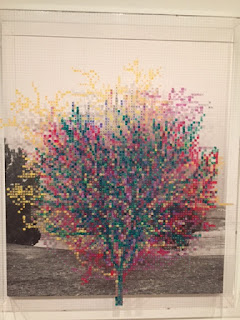This week’s unit is about space exploration and art. Professor
Vesna started this week’s unit off with talking about the beginning of space
exploration through the telescope. In 1608 a Dutch eyeglass maker named Hans
Lippershey applied the first patent for a telescope. He claimed that it could
see things with three times the magnification. However, Galileo Galilei was the
first to point his own design of a telescope skyward in order to study the
stars. With this he discovered that the moon had craters and mountains and that
Jupiter had many moons.


I enjoyed learning about how space began to influence modern
culture beginning in the 1920’s. Many writers began to write books about space
travel, which in a way marked the beginning on the fusion of space and art. For
example, in 1929 Konstantin Tsiolkovsky was the first person to write about a
complete space station with the means to do research and have people live in it
for long periods of time. This was 28 years before the first simple small satellite;
Sputnik was successfully launched into orbit. Many TV shows and movies about
space such as The Jetsons, Star Trek, and Star Wars became very popular around
this time.


In today’s world space and art have been intertwined even
more. I found the KSEVT institute to be really interesting and I enjoyed
looking at all the different ways they combine art and performance with
science. The Cultural Space Programme’s goal is to work on the culturalisation of
space in today’s society and has done projects such as a zero gravity theater
performance. They focus on the humanities and art and are constantly asking the
question “What is it like to be a human in space? (KSEVT)”
Works Cited
Contributor, Lauren Cox SPACE.com. "Who Invented the Telescope? | The First Telescope | Space.com." Space. N.p., 13 July 2013. Web. 31 May 2015. <http://www.space.com/21950-who-invented-the-telescope.html>.
"Corning Museum of Glass." The Quest to See More: Glass Lenses. N.p., n.d. Web. 31 May 2015. <http://www.cmog.org/article/quest-see-more-glass-lenses>.
"Cultural Space Programme." KSEVT. N.p., n.d. Web. 31 May 2015. <http://www.ksevt.eu/2015/?page_id=1849>.
"Dragan Zivadinov «Zero Gravity Biomechanical Theater» 1999. | Φrbit° Sφaceφlace :: Art in the Age øf Φrbitizatiøn." Dragan Zivadinov «Zero Gravity Biomechanical Theater» 1999. | Φrbit° Sφaceφlace :: Art in the Age øf Φrbitizatiøn. N.p., 23 Apr. 2006. Web. 31 May 2015.
Pinchefsky, Carol. "CBS Blocks Production of 'Star Trek' Fan Film."Forbes. Forbes Magazine, 29 Mar. 2012. Web. 31 May 2015. <http://www.forbes.com/sites/carolpinchefsky/2012/03/29/cbs-blocks-production-of-star-trek-fan-film/>.
"SFE: The Science Fiction Encyclopedia." Authors : Tsiolkovsky, Konstantin : SFE : Science Fiction Encyclopedia. N.p., 29 Oct. 2014. Web. 31 May 2015. <http://www.sf-encyclopedia.com/entry/tsiolkovsky_konstantin>.
"6 Signs We Are Living Like The Jetsons - ON.com Blog." ONcom Blog RSS. N.p., 20 June 2014. Web. 31 May 2015. <http://blog.on.com/6-signs-we-are-living-like-the-jetsons/>.

















